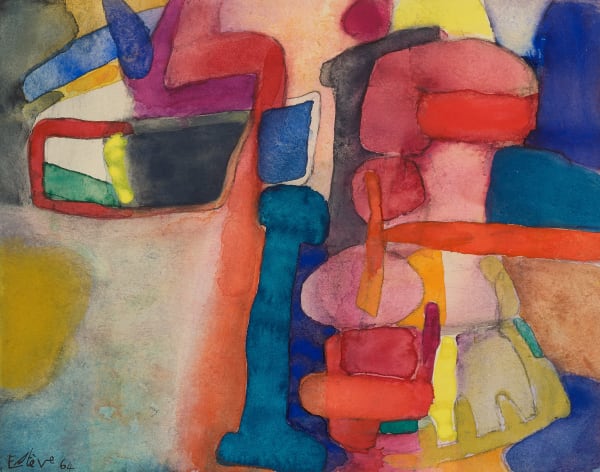Maurice Estève (1904 – 2001) was undoubtedly a leading representative of the first generation of artists – which included Bissière, Bazaine, Manessier, Singier and Le Moal who, after the Second World War, chose to work on non-figurative art. As an abstract colourist, Estève's practice was focused on the interlacing of form and colour.
Maurice Estève was born in Culan, in the Cher, where he spent his childhood with his grandparents. He later moved to Paris to live with his parents: his father was a cobbler, and his mother a dressmaker. Whilst visiting the Louvre in 1913, he was impressed by Courbet, Delacroix, Chardin, and above all, by Paolo Uccello's Bataille de San Romano. After spending the years of the First World War back in Culan, he returned to Paris in 1918, employed as a typographer’s apprentice by day, later joining a workshop in designing modern furniture and taking evening classes in drawing.
Estève trained his eye by studying a group he dubbed the 'Primitifs': Nicolas Poussin (1594-1665), Fouquet and, above all, Paul Cezanne (1839-1906), whom Estève referred to as ‘a saint of painting'. He was largely self-educated, his evening classes and the free studio of the Colarossi academy in 1924 being his only formal training. Whilst there, he tried to constructively implement his own motifs using the artistic framework of George Braque (1882-1963) and Fernand Léger (1881-1955).
Estève's extensive artistic output was not limited to the medium of painting, he also experimented with collages, murals, stained glass and tapestry design. No doubt his stint at a workshop of shawl and fabric design in Barcelona in the year of 1923 had an influence on him. He was quite quickly noticed by the older generation of artists, Braque, Matisse, Delaunay, Picasso. In 1937, Robert and Sonia Delaunay, who were responsible for the decoration of the aviation and railway pavilions at the Paris Universal Exhibition, invited him to participate in the murals of the exhibition.
An exclusive contract with the gallery Louis Carré began in 1941 and finally allowed Estève to devote himself entirely to his art. This led to a series of exhibitions with the gallery. During that time, Estève was particularly influenced by Bonnard and his treatment of light and colours.
In 1948 the Galerie Carré held its first solo exhibition of the painter's work: Trente peintures 1935–1938, 1941–1947, showing his work again in 1965 with Vingt-quatre peintures 1935–1947.
Estève, now a vital representative of the French scene, began exhibiting abroad: in 1946 at the Stedelijk Museum in Amsterdam, along with the artists Bazaine and Lapicque, and later in Copenhagen, where he was invited by John Rubow for an important solo exhibition at Statens Museum for Kunst in 1956. In the same year he also had an exhibition at the Svensk-Franska Konstgalleriet in Stockholm.
In 1967, Estève began a series of exhibitions with Galerie Nathan in Switzerland and also began showing with Galerie Claude Bernard in Paris. This series of exhibitions displayed the artist's various interests, from collage to watercolour, displaying Estève's diverse interests and evolving talent.
Following a significant retrospective of his work at the Grand Palais, Paris in 1986, the Musée Estève was inaugurated in Bourges in 1987. It followed the artist's desire to show his work to a large audience.
Estève's oeuvre undeniably established a new pictorial language: form and colour were embodied by lyricism, expressed with an almost poetic attitude.
Estève’s work is included in numerous global museums, such as, the Museum of Modern Art (MOMA), New York; Tate Gallery, London. The artist’s works can also be found in the Saatchi collection, along with many private collections.










































